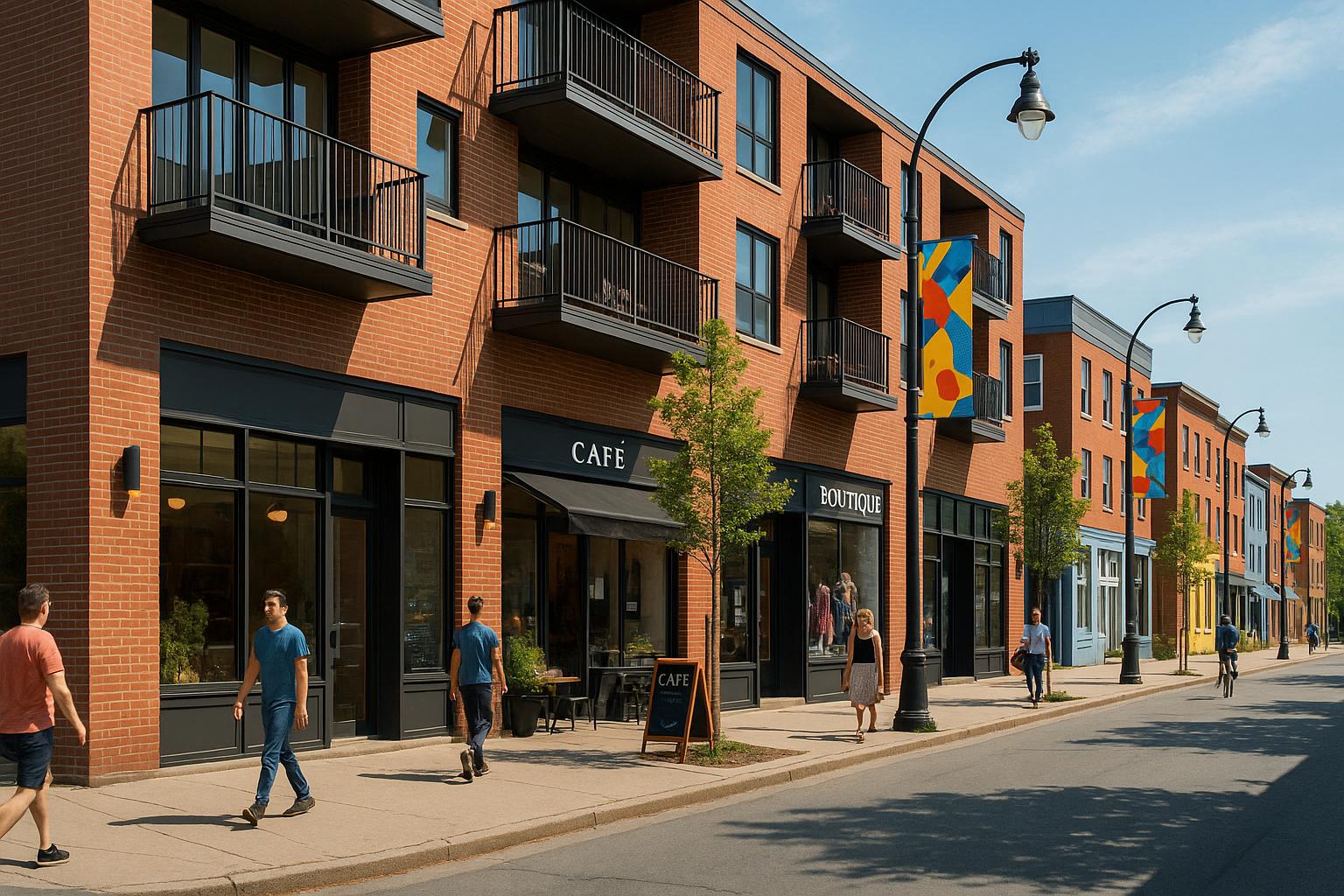Nova Scotia winters are tough - freezing temperatures, heavy snow, and coastal storms. To keep your home warm, durable, and energy-efficient, focus on these key areas:
- Insulation & Air Sealing: Use continuous insulation and seal air leaks to prevent heat loss and moisture issues.
- Foundation & Roof Design: Build below the frost line and use reinforced roofs to handle frost heave and snow loads.
- Cold-Climate Windows & Materials: Install triple-pane windows, insulated doors, and durable siding like fibre cement or vinyl.
- Heating & Ventilation: Opt for heat pumps with backup systems like wood stoves and ensure proper ventilation with HRVs.
- Outdoor Layout: Design driveways for snow management, position windows for solar heat, and use wind barriers for protection.
These strategies not only make your home comfortable but also reduce energy bills and prevent winter damage. Keep reading for detailed tips on how to prepare your home for Nova Scotia’s harsh winters.
DIY - Draft- Proofing With Efficiency Nova Scotia

Insulation and Air Barrier Systems
Proper insulation and air sealing play a big role in keeping indoor temperatures steady and improving energy efficiency. This protective layer, known as the thermal envelope, is the foundation for the techniques outlined below.
High-Performance Insulation
Homes in Nova Scotia designed for colder months often rely on advanced insulation methods. Using continuous insulation helps eliminate thermal bridging - those weak spots where heat escapes through framing. Materials like rigid foam boards or mineral wool panels applied to the exterior create a seamless layer, reducing heat loss and improving overall performance.
Air Barrier Installation
Air leaks can undermine insulation by letting in drafts and moisture. Common problem areas include windows, doors, electrical outlets, plumbing openings, rim joists, and attic hatches. To tackle these issues, seal small gaps with high-quality caulk, larger openings with expanding foam, and apply self-adhering membranes or specialized tapes to create a continuous air barrier.
"Controlling air leakage is crucial for preventing moisture condensation within walls and attics, which can lead to mold growth and structural damage", says Natural Resources Canada's building science team.
When paired together, effective insulation and airtight sealing provide strong protection against Nova Scotia's harsh winters, improving indoor comfort and cutting energy costs over the long term.
Winter-Ready Foundation and Roof Construction
To prepare for Nova Scotia's harsh winters, it's crucial to focus on structural elements like foundations and roofs. These components must handle frost damage and heavy snow loads effectively. Let's dive into foundation strategies to combat frost heave and roof designs that manage snow accumulation.
Below-Frost-Line Foundations
In Nova Scotia, the frost line typically reaches about 1.2 metres (4 feet) below ground. Foundations need to extend beyond this depth to avoid frost heave, which can lift and crack concrete.
Here are two effective ways to protect foundations:
- Deep Foundations: Use reinforced concrete footings that extend below the frost line, meeting building code requirements.
- Insulated Foundations: Apply rigid foam insulation around the foundation to maintain stable soil temperatures and prevent frost damage.
Once the foundation is secure, attention shifts to designing roofs that can handle snow efficiently.
Snow-Load Roof Systems
Roofs in Nova Scotia must be built to endure heavy snow. Key considerations include:
Roof Pitch and Structure
- A roof pitch of at least 4:12, paired with engineered trusses, encourages snow to slide off.
- Additional structural reinforcements are essential in areas with extreme snowfall.
Ventilation Systems
- Continuous soffit and ridge vents promote airflow.
- Proper attic insulation helps maintain a cold roof surface.
- Air sealing between the living space and attic prevents warm air from escaping, reducing the risk of ice dams.
To further protect your roof, consider these components:
| Component | Purpose | Winter Benefit |
|---|---|---|
| Ice and Water Shield | Waterproof membrane | Protects against water damage from ice dams |
| Continuous Ridge Vent | Ensures attic ventilation | Keeps roof temperature consistent |
| Insulated Soffit Vents | Improves air circulation | Prevents condensation buildup |
Cold-Climate Windows and Building Materials
Cold-Weather Windows and Doors
Keeping your home warm during the winter starts with high-quality windows and doors. Triple-pane glass and low-emissivity (low‑E) coatings are excellent for reducing heat loss while still letting in plenty of natural light and solar warmth.
Here are some key window features to consider for cold weather:
| Feature | Benefit |
|---|---|
| Triple‑pane glass | Provides better insulation compared to double-pane windows |
| Low‑E coating | Reflects heat back inside your home to keep it warmer |
| Argon gas fill | Boosts the insulating capability of the window |
| Insulated frames | Reduces heat transfer and condensation |
For doors, look for models with insulated cores, proper weatherstripping, door sweeps, and even storm doors for an extra layer of protection.
But it’s not just about windows and doors - your choice of exterior materials matters, too.
Winter-Resistant Exterior Materials
Nova Scotia’s tough winters, with their freeze-thaw cycles and heavy precipitation, call for durable and weather-resistant materials. For roofing, consider:
- Metal roofing with standing seams: Helps snow slide off easily.
- Architectural shingles: Designed to handle cold climates.
- Ice and water shield membranes: Installed near roof edges for added defence against leaks.
When it comes to siding, durability and moisture resistance are crucial. Some good options include:
- Fibre cement boards: Stand up well to moisture changes.
- Vinyl siding: Made to resist impacts in colder temperatures.
- Engineered wood products: Often come with built-in moisture barriers.
Adding protective layers can further safeguard your home:
| Protective Layer | Location | Purpose |
|---|---|---|
| Vapour barrier | Interior walls | Prevents moisture from moving through walls |
| Air barrier | Exterior walls | Cuts down on drafts and wind penetration |
| Weather barrier | Beneath siding | Provides extra moisture protection |
Together, these materials and design choices help maintain a warm, energy-efficient, and comfortable home throughout Nova Scotia’s long, cold winters.
sbb-itb-16b8a48
Heating and Air Quality Systems
A well-thought-out heating and ventilation system is essential for handling Nova Scotia's harsh winters comfortably.
Main and Backup Heat Sources
Heat pumps are a popular choice because they provide both heating and cooling while consuming less energy than many traditional systems.
| Heating System | Advantages | Considerations |
|---|---|---|
| Air-source heat pump | Efficient even in colder climates | Needs a backup heat source |
| Ground-source heat pump | Reliable performance year-round | Higher upfront installation costs |
| Hybrid system | Combines heat pump and furnace | More dependable in extreme cold |
For backup heat, consider a wood stove or propane fireplace. Also, make sure your electrical panel allows for a backup generator connection to keep things running during power outages.
Pairing an efficient heating system with proper air management ensures your home stays comfortable, no matter how cold it gets.
Managing Air Quality in Winter
Good air quality is just as important as reliable heating. During winter, tightly sealed homes limit natural ventilation, so a proper ventilation system is crucial. A heat recovery ventilator (HRV) is a great option - it replaces stale indoor air with fresh outdoor air while preserving heat, helping to prevent condensation and maintain energy efficiency.
Key components for winter air quality include:
| Component | Purpose | Winter Advantage |
|---|---|---|
| HRV System | Replaces stale air and retains heat | Maintains energy efficiency indoors |
| Humidity Control | Regulates indoor moisture levels | Prevents condensation and mould |
| Kitchen Range Hood | Removes cooking-related moisture | Reduces overall indoor humidity |
| Bathroom Fans | Extracts excess moisture | Prevents steam buildup |
Keep indoor humidity between 30%-50% during winter. Install a carbon monoxide detector and seal garage doors properly to block exhaust fumes from entering your home.
Don’t forget to clean or replace filters monthly during the heating season to keep your systems running smoothly. A smart thermostat can also help by monitoring indoor conditions and adjusting ventilation as needed.
Winter Site Layout and Planning
When preparing for Nova Scotia's tough winters, the outdoor layout of your property plays a key role in keeping your home ready. A well-thought-out site design works hand-in-hand with your home's structure to boost its winter performance and protect it from the elements.
Snow Management Design
For easier snow removal, design driveways with a gentle slope and include a turnaround area for snow-clearing equipment. Adding a covered entrance or mudroom can provide a safe space for snow and ice to melt before entering the house. To minimize snow drifts, align garage openings with the direction of prevailing winter winds. These small adjustments can make winter maintenance easier and support your home's energy efficiency.
Solar Heat and Wind Barriers
Take advantage of natural sunlight to keep your home warmer during winter. Position your house and windows to capture as much southern sunlight as possible. Use trees, fences, or other landscaping elements to act as windbreaks, shielding your home from cold winds. Just be sure these wind barriers don't interfere with snow-clearing efforts.
Weather Protection Features
Beyond insulation, foundation work, and heating strategies, there are extra steps you can take to help your home withstand harsh winter conditions.
In Nova Scotia, a winter-ready home must be prepared for severe storms and potential power outages.
Storm-Ready Construction
To handle strong winds and heavy snow, ensure roof trusses are securely anchored and that roof-to-wall connections are reinforced.
Power Outage Systems
Consider installing a standby generator with an automatic transfer switch to keep essential systems running, such as heating, pumps, refrigeration, lighting, and security. For short-term power needs during outages, battery backup systems are a great addition. A hybrid setup, combining a generator with battery storage, can also help reduce fuel usage.
Ensure all backup power systems meet the Canadian Electrical Code and local regulations. These additions work alongside other winter-proofing measures to keep your home functional during extreme weather.
Conclusion: Winter Home Performance Results
Preparing a home for Nova Scotia's winters means more than just staying warm - it’s about improving comfort, reducing costs, and ensuring durability. Modern building methods make homes better equipped to handle harsh weather while keeping operating expenses low.
For example, homes built to today’s standards can be up to 60% more energy efficient than older ones. This efficiency leads to noticeably lower heating bills during the winter months.
Key design elements like below-frost-line foundations, reinforced roofs, and cold-climate windows not only protect against the elements but also reduce maintenance needs and extend the life of essential components. These features work together to improve the home’s overall performance.
By combining proper insulation, efficient heating systems, and well-thought-out site planning, homeowners can enjoy steady indoor temperatures throughout the season. This means consistent comfort, no matter which room you're in.
Additionally, features like storm-resistant construction and backup power systems ensure your home stays functional during severe weather. This helps avoid costly emergency repairs and offers extra peace of mind when winter storms hit.
When all these elements - foundation, insulation, heating, and more - come together, the result is a home built to thrive in Nova Scotia’s challenging winters. The payoff? Lower energy bills, reduced upkeep, and long-lasting comfort.
FAQs
What are the advantages of using a heat pump in a winter-ready home in Nova Scotia, and how does it perform compared to traditional heating systems?
Heat pumps offer several advantages for winter-ready homes in Nova Scotia. They are highly energy-efficient, transferring heat rather than generating it, which can significantly lower heating costs. Modern heat pumps are designed to perform well even in cold climates, making them a reliable option for Nova Scotia’s winters, where temperatures can drop below -8°C.
Compared to traditional heating systems like oil or electric baseboards, heat pumps provide more consistent and even heating throughout the home. They also double as air conditioners in the summer, offering year-round comfort. For added resilience, many homeowners pair a heat pump with a backup heat source, such as a high-efficiency furnace or wood stove, to ensure reliable heating during extreme cold spells or power outages.
How can I manage snow and ice around my home to prevent damage and improve energy efficiency during Nova Scotia winters?
To manage snow and ice effectively in Nova Scotia's harsh winters, start with a well-designed roof. Opt for a steeper pitch to shed snow naturally and ensure reinforced trusses to handle heavy snow loads. Proper attic ventilation is essential to prevent melt-freeze cycles that lead to ice dams, which can damage your roof and gutters.
For the exterior, choose durable materials like metal roofing, which allows snow to slide off easily, and install ice and water shield membranes along roof eaves for added protection. When planning your site, consider snow accumulation areas and ensure driveways are graded for efficient snow removal. If possible, position your home to take advantage of winter sunlight to help naturally melt snow in key areas like the driveway.
How can I design my home's foundation and roof to handle Nova Scotia's frost heave and heavy snow loads?
In Nova Scotia, designing a home to withstand frost heave and heavy snow loads requires careful planning. For the foundation, ensure footings are placed below the frost line, which is typically around 1.2 metres (4 feet). Adding insulation, such as insulated concrete forms or rigid exterior insulation, can help keep basements warmer and prevent frost-related damage.
For the roof, opt for a steeper pitch to allow snow to slide off more easily and reinforce trusses to meet the regional snow load requirements outlined in Nova Scotia's building code. Proper attic ventilation is also essential to prevent ice dams, which can form during freeze-thaw cycles. Features like cold roofs and well-insulated eaves can further protect your home from winter damage.



